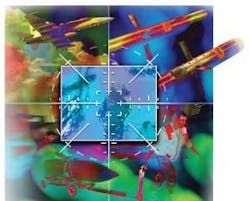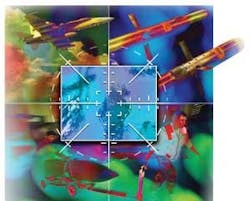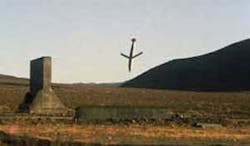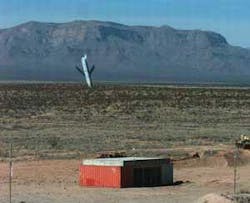Incoming! Precision guidance keeps munitions on target
Lasers, global positioning systems, and other modern technologies have made hitting fixed targets with missiles and bombs extremely efficient. Now defense experts are designing systems to hit targets on the move and beyond line of sight.
By John McHale
Many an American general talking to the press has commented that the difference between the terrorists and U.S. forces when it comes to collateral damage is that the terrorists do not care if they kill innocents, while U.S. commanders do everything possible to limit civilian deaths during air strikes and elsewhere in battle.
This is no idle boast as today’s precision-guidance technology–accurate to within a meter–for missiles and other ordnance enable U.S. forces to strike targets surgically such as small buildings in crowded cities with minimal damage to surrounding structures.
The precision weaponry played a decisive role in Afghanistan following the terrorist attacks of Sept. 11, 2001.
U.S. Special Forces used laser designators to mark specific targets such as battalions of Taliban troops and other fixed targets throughout the country. The missile strikes that followed were so precise that the Northern Alliance forces called the designators America’s Death Ray, according to the book “Jawbreaker,” by Gary Bernsten, the CIA’s field commander in Afghanistan.
Even more impressive are the electronics that guide the missiles and bombs to the target marked by the Special Forces lasers.
“Precision engagement weapons are made possible through the combination of several combat-proven guidance packages, targeting technologies, and operational modes,” says Randy Bigum, vice president for strike weapons, at Lockheed Martin Missiles and Fire Control in Orlando, Fla.
“Precision accuracy for many of today’s systems starts with an inertial navigation system capable of being updated in-flight with anti-jam global positioning system (GPS) data, providing pinpoint targeting with limited collateral damage,” Bigum says. Terminal phase precision “for some systems is enabled by at least one sensor mode, such as laser, electro-optic, infrared, or radar frequency.” “In the endgame, the seeker refines the route for optimum performance,” he says. “Increasingly, we expect to see seekers using several modes for even more precision and less degradation from countermeasures.
“Other systems employ combat-proven GPS/inertial navigation combined with vertical attack trajectories to precisely strike targets, even in urban environments with friendly forces in close proximity to the targets,” Bigum continues.
“We’ve already achieved a high degree of precision against static targets through GPS, imaging infrared guidance, and laser-guided weapons,” says Harry Schulte, Raytheon Missile Systems vice president of air warfare systems in Phoenix. “We’re really good at hitting buildings, bunkers, and other fixed targets. The challenge is hitting moving targets. For example, some of Raytheon’s laser-guided missiles are good at hitting moving targets, but to employ the weapon the pilot needs to see the target or have a sensor that cues the weapon to the target.
“The latest developments in guidance involve the integration of several modes operating simultaneously and synergistically,” Bigum says. “This requires advanced and sophisticated processes and algorithms. Combining GPS and inertial navigation is a proven, accurate system for terminal guidance. Advances in electronics and computing capabilities also provide for more accurate guidance at lower overall cost to the customer.”
Bigum says he also sees reconnaissance as an application for future missile guidance systems.
“Potentially, missile seekers could operate en route to perform reconnaissance of potential targets or gather battle damage assessments,” Bigum notes. “For example, while on its way to its pre-planned target, a long-range cruise missile could be diverted to overfly an area of interest to military planners. They could use its seeker to view the area and send the images back to the planners, who could then take necessary action in regard to potential threats in that area. The missile would then continue on its flight path and strike its intended target. This would provide planners with a set of precision engagement tools in a rapidly changing threat environment.”
Hitting moving targets with JSOW
“The next evolution is hitting moving targets that the pilot can’t see and you do that with datalinks,” Raytheon’s Schulte says. “This is an area where Raytheon is really leading the way, and let me give you one example–Raytheon’s Joint Standoff Weapon C-1.
“The JSOW C-1 is a spiral development of the JSOW-C, which is a glide weapon with a 130-kilometer range and an Imaging Infrared (IIR) seeker,” Schulte continues. “The JSOW C mission enables prosecution of stationary land targets with pinpoint accuracy through mission planning and automatic target acquisition (ATA) software algorithms beyond the pilot’s visual range.”
JSOW receives the targeting information in preplanned mode, in the cockpit with data received while airborne through onboard sensors, or through other third-party targeting assets.
It enhances the “JSOW C with pinpoint accuracy against a moving maritime target (MMT) set,” Schulte says. “This capability is mechanized via a datalink and additional MMT algorithms, providing the JSOW C-1 the ability to engage moving maritime targets, well outside the pilot’s ability to see the target, while maintaining its existing fixed target capability.
“Basically, what might happen in a notional engagement is that an F/A-18 pilot would drop the JSOW C-1 outside of target area threats and then via datalinked target updates provided by a third-party targeting platform–which could be another F/A-18 or ISR platform–providing continuous target updates to the JSOW,” Schulte says. “Once the C-1 gets close to the target area, it would begin using its IIR seeker to search for and engage the moving maritime target eliminating GPS and platform sensor targeting errors. Datalinked weapons are going to be extremely important.”
According to the JSOW data sheet, the weapon family is “modular in design with variants that can integrate different lethal submunitions, and a blast/fragmentation unitary warhead and a hardened target penetrator that can be programmed for blast and fragmentation effects.
JSOW targets range from area targets to hard-point targets, according to its data sheet. Its stealth capability includes a low-radar cross section and infrared signature.
The JSOW data sheet states the weapon is “designed to take advantage of developments in payloads and sensors through design modularity of the air vehicle.” “The payload bay can accommodate lethal and nonlethal payloads– from warheads to pamphlets to sensor packages. The terminal seeker space can accept sensors as they are developed.”
The JSOW is compatible with the U.S. Air Force F-16, F-15E, B-52 Bomber, F-35 Joint Strike Fighter, U.S. Navy F/A-18, and P-3. It also has a MIL-STD-1553/1760 and NATO STANAG 3837 AA interface.
The C-1 also just completed a critical design review, and a technology demonstration phase is underway leading to a spring 2009 JSOW Extended Range (ER) Free Flight Test.
Laser guidance
Another “exciting area for Raytheon is our laser-guided technology,” Schulte continues. “For example, our Enhanced Paveway II Lot 5 incorporates a wide field of view semi-active laser seeker designed to give our combat proven weapon the capability to hit targets at speeds exceeding 70 mph. If the weapon is launched against targets at altitudes of 20,000 feet or greater it can hit targets located in a 100 square-mile footprint at ranges over 10 miles from the launch aircraft without requiring target velocity updates prior to launch or during weapon fly out.
“One thing I think that is worth pointing out is that like the JSOW, the EP2 uses several types of guidance–it’s a dual-mode system,” Schulte notes. “So, the EP2 can use GPS against stationary targets–although it can also use laser guidance, if the pilot chooses to use that mode. But, for relocatable or moving targets the system will use a designator. This dual-mode weapon gives the warfighter unmatched flexibility.
“Raytheon’s AGM-65 Laser Maverick missile has historically been extremely good at hitting moving targets,” Schulte points out.
According to its data sheet, the Laser Maverick (AGM-65) uses a semiactive laser (SAL) seeker that tracks laser energy reflected from a target being illuminated by a laser designator device, either airborne or ground-based. “Its analog SAL seeker provides long-range, lock-on, fire-and-forget capability that incorporates safety features for collateral damage avoidance by flying long and deactivating the warhead on loss of laser designation.”
Maverick also has configurations based on television and infrared seekers. The weapon dates back to the 1980s, when it was used against armored targets and to provide close air support, according to its data sheet.
For the next-generation Laser Maverick, Raytheon engineers are designing a laser guidance and control section (GCS) to allow production of Laser Maverick (AGM-65E2) missiles. “It uses digital Semi-Active Laser (dSAL) seeker technology that allows tighter tracking against high-speed moving targets and greater precision in tough urban environments, while minimizing collateral damage,” according to its data sheet. The GCS uses key components from existing Mavericks such as circuit card assemblies, autopilot, and electrical interfaces. It mates to existing center-aft sections and retains Maverick shape and mass properties to reduce cost and schedule time, according to the data sheet.
The missile uses built-in-test to limit test equipment requirements. No aircraft operational flight program changes are acquired nor is a change in launch aircraft. “Incorporating GPS/INS features is under consideration to improve end-game accuracy, permit adverse weather employment, and offer an expanded engagement envelope,” according to the Maverick data sheet.
Obsolescence management
The electronics technology brings many marvels to precision-guidance applications, but also carries a headache or two when it comes to obsolescence. Missile guidance system designers struggle just as much as the rest of the industry to keep up with the life cycle management issues that follow commercial off-the-shelf (COTS) electronics.
“We work aggressively to mitigate obsolescence issues before they become a serious problem,” Schulte says. “For example, when we designed the JSOW C-1 seeker electronics to add more processing capacity for moving maritime targets, we also knew we would face obsolescence issues with other parts of the weapon, including the IIR sensor in the seeker.
“So, at the same time we designed the seeker electronics, we also worked with our U.S. Navy customer and redesigned some components to address obsolescence issues,” Schulte continues. This approach will help us avoid serious–and potentially expensive–problems in the future.
“Obsolescence is a real concern for modern weapons having a long shelf life and warranties, Bigum says. “Currently, Lockheed Martin builds into our design an obsolescence roadmap for COTS components that recognizes the ever-increasing demands on technology refresh cycles. In this manner, we anticipate obsolescence instead of reacting to it.
Bigum says it is an evaluation process, looking for “opportunities to improve design and use technological developments to make the most of value for our customer, particularly in the area of electronic and electro-optical components.”
Bigum adds that Lockheed Martin’s precision-guidance designs, such as the Paveway II Laser Bomb Kits “balance custom and COTS parts.” “The actual mix of COTS vs. custom design varies from product to product.”
The key Paveway electronics are the computers in the front-end guidance system, Bigum says. He declined to name specific hardware and software suppliers to the program.
Boeing designers researching inertial navigation upgrades for Minuteman III missile
Boeing in St. Louis is examining several parameters to upgrade inertial navigation instrumentation on the Minuteman III missile guidance kits to extend the operational life of the guidance systems through 2030, says Charles Dutch, Boeing Minuteman Guidance Replacement Program director.
Parameters include increasing the mean time between failures (MTBF), making it more efficient to replace and repair without destacking missiles, improving target flexibility, maintaining or improving current levels of accuracy, and enhancing and improving health and status monitoring, Dutch says.
The operational MTBF and reliability has already proven to be at least twice what was initially required, Dutch notes.
Boeing engineers are also “studying implementation of the digital wing to automate many of the functions that are performed manually,” Dutch says. “We are performing a system study to help define the architecture of the future, taking into account the future guidance improvements, along with ground system and network upgrades.”
On the Minuteman III missile set, Honeywell engineers replaced the older guidance electronics including the flight computer and inertial measurement unit electronics, Dutch says. The nuclear-hardened electronics were custom-designed, he adds.
“The Missile Operational Ground and Flight software received a functional rehost of the existing Minuteman III software to run on the flight computer,” Dutch says.
The Operational Ground Program (OGP) performs all missile control functions for ground operations. It communicates with the Launch Control Facility (LCF), and the Airborne Launch Control Facility (ALCC). The Operational Flight Program (OFP) guides the missile to a certain point in space so a set of predefined reentry objects–Reentry Vehicles or Chaff–can be deployed.
“Boeing produced many of the components at our facility in El Paso, Texas, and assembled the guidance sets in Heath, Ohio,” Dutch says. Honeywell is the main subcontractor on the program. About 50 other key suppliers were used during the production program. The quantity has changed over the 10 years of production, Dutch says.
To manage obsolescence, Boeing constantly reviews the “supplier base used as many key suppliers have merged, changed their market focus, or exited the business altogether,” Dutch says. Several strategies were used to mitigate these conditions including “lifetime buys, qualifying several sources, corporate purchase agreements, design changes when a substitute part was not available, and design changes to reduce the cost sensitivity or exposure to single sources for a critical component.”
Boeing is scheduled to deliver the final upgraded missile guidance electronics set for the Minuteman III in December as part of the Guidance Replacement Program (GRP). GRP is one of eight major Intercontinental ballistic missile (ICBM) upgrade programs designed to modernize and maintain the reliability, safety, and security of the nation’s entire force of land-based Minuteman III missiles, according to Boeing’s web site. Northrop Grumman is the prime contractor on the ICBM Prime team.
Making the old new
One of Raytheon Missile Systems’ most popular guidance upgrades among warfighters is the Excalibur projectile, say Raytheon officials in Phoenix, Ariz. It uses a global positioning system to provide modern accuracy to legacy ordnance.
In 2007 the Excalibur weapon won a “Top 10 Army Greatest Inventions of the Year” award, company officials say.
The Excalibur round was “amazingly accurate,” and its fires produced a 92 percent success rate, says Capt. Victor Scharstein, assigned to the U.S. Army’s 1st Cavalry Division. He commanded a firing battery that employed Excalibur in Iraq, Raytheon officials say.
Raytheon officials announced the next increment in the program–Excalibur 1b. According to a Raytheon release, the “design uses fewer parts and is easier to manufacture than the 1a round.”
Excalibur 1a is all-weather, precision munition that has repeatedly demonstrated better than 10-meter (32-foot) accuracy in combat, according to a Raytheon public release. This accuracy enables U.S. warfighters to employ Excalibur within 70 meters (229 feet) of their own position, saving lives and limiting collateral damage.
“The Excalibur 1b combines the incredible success and reliability of the Excalibur 1a with a lower unit production cost,” says Steve Bennett, Raytheon Missile Systems’ Excalibur program director, in the release. “It is a game changer for soldiers deployed to Iraq and Afghanistan.”
The contract award begins an 18-December design and maturation demonstration phase. It will be followed by a downselect for the 18- to 30-December system qualification phase and three years of low-rate initial production, Raytheon officials say.




